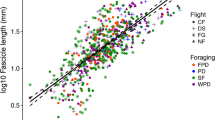Summary
-
1.
Discharge patterns in the motoneurons innervating the propodite stretcher and bender muscles and dactylopodite opener and closer muscles of the legs of the land crab, Cardisoma guanhumi, were recorded during sideways walking on a styrofoam wheel (Fig. 1).
-
2.
Rhythmic bursts of activity in these motoneurons can be correlated with leg movements during walking in both leading and trailing legs (Figs. 2, 3A, B, D). Similar patterns of activity can be recorded in animals freely walking on a bench (Fig. 3C).
-
3.
These motor output patterns are quite different from those occurring in the same motoneurons during resistance reflexes. In particular, the shared openerstretcher excitor and the stretcher inhibitor show no preferential phase relationship during walking (Figs. 4, 5). It appears that the normal movements of the propo-dactylopodite (P-D) joint during walking do not give rise to resistance reflexes.
-
4.
Opening and closing movements of the P-D joint, manually imposed during walking, induce resistance reflexes (Figs. 6, 7). Reflexes tend to be stronger, both in terms of number of impulses and impulse frequency, when the imposed movement opposes rather than reinforces ongoing P-D movements.
-
5.
Animals walking sideways on the wheel with the P-D joint clamped rigidly in a stable position show only slight changes in their motor output patterns from those seen during normal walking (Fig. 3E).
-
6.
A model is discussed in which the proprioceptive input resulting from the normal movements of the P-D joint during walking is inhibited centrally and so does not give rise to a resistance reflex.
-
7.
These results clearly indicate that resistance reflexes do not play an important role in coordination of antagonistic muscles during walking. Instead it is likely that their primary function is to compensate for changes in the load applied at a joint as would occur on steep inclines and irregular surfaces.
Similar content being viewed by others
References
Atwood, H.L., Walcott, B.: Recording of electrical activity and movement from legs of walking crabs. Canad. J. Zool. 43, 657–665 (1965).
Bässler, U.: Zur Regelung der Stellung des Femur-Tibia-Gelenkes bei der Stabheuschrecke Carausius morosus in der Ruhe und im Lauf. Kybernetik 4, 18–26 (1967).
Clarac, F., Beaubaton, D.: Perturbations réversibles des programmes locomoteurs induites par blocage articulaire chez le crabe Carcinus. C. R. Soc. Biol. (Paris) 163, 2646–2649 (1969).
Cohen, M.J.: The crustacean myochordotonal organ as a proprioceptive system. Comp. Biochem. Physiol. 8, 223–243 (1963).
- Evoy, W.H.: Central and peripheral control of walking and posture in crabs. (In preparation.)
Evoy, W.H., Cohen, M.J.: Sensory and motor interaction in the locomotor reflexes of crabs. J. exp. Biol. 51, 151–169 (1969).
Hoyle, G.: Exploration of neuronal mechanisms underlying behavior in insects. In: Neural theory and modeling (Reiss, R.F., ed.), p. 346–376. Stanford, Cal.: Stanford Univ. Press 1964.
Moody, C.J.: A proximally directed intersegmental reflex in a walking leg of the crayfish. Amer. Zool. 10, 501 (1970).
Pearson, K.G., Iles, J.F.: Discharge patterns of coxal levator and depressor motoneurons of the cockroach, Periplaneta americana. J. exp. Biol. 52, 139–165 (1970).
Roberts, T.D.M.: Neurophysiology of postural mechanisms. London: Butterworths 1967.
Runion, H.I., Usherwood, P.N.R.: A new approach to neuromuscular analysis in the intact free-walking insect preparation. J. Insect Physiol. 12, 1255–1263 (1966).
— —: Tarsal receptors and leg reflexes in the locust and grasshopper. J. exp. Biol. 49, 421–436 (1968).
Spirito, C.P., Evoy, W. H., Barnes, W.J.P.: Nervous control of walking in the crab Cardisoma guanhumi. I. Characteristics of resistance reflexes. Z. vergl. Physiol. 76, 1–15 (1972).
Whitear, M.: The fine structure of crustacean proprioceptors. I. The chordotonal organs in the legs of the shore crab, Carcinus maenas. Phil. Trans. B 245, 291–325 (1962).
Author information
Authors and Affiliations
Additional information
Supported by National Science Foundation grant GB 8447, NICHHD Training Grant HD00187, and grants from the Carnegie Trust for the Universities of Sootland and the Browne Research Fund of the Royal Society of London. We are grateful to Margo Stahl and Brooks Jones for assistance, and to Dr. George Dauth for design of a computer program to plot instantaneous frequency.
Rights and permissions
About this article
Cite this article
Jonathan, W., Barnes, P., Spirito, C.P. et al. Nervous control of walking in the crab, Cardisoma guanhumi . Z. vergl. Physiologie 76, 16–31 (1972). https://doi.org/10.1007/BF00395498
Received:
Issue Date:
DOI: https://doi.org/10.1007/BF00395498




